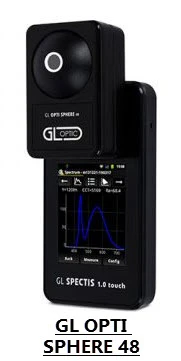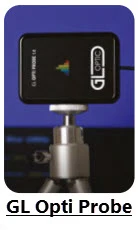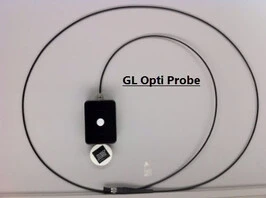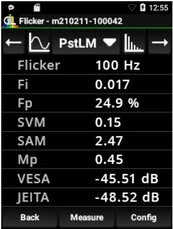GL SPECTIS 1.0 touch
Graphic & Printing Industry > Light measurement
GL SPECTIS 1.0 TOUCH
The world’s first and most powerful handheld spectral light meter
Light Spectrometer for immediate evaluation of illuminance, color and flicker metrics in one device
Unique Features:
- Completely portable device
- Color LCD Touch screen
- Communication features: USB cable, SDcard slot
- Android based operating system
- Approx. 4 hours on battery
- contains the analysis software, with on-screen display of results
- data can be exported in tabular form.
- Application : Natural Light, Leds, halogen light, etc
IF YOU NEED TO MEASURE:
• illumination value - Lux
• luminous flux - Lumen
• color rendering index according to CIE - CRI
• correlated color temperature according to CIE standard - CCT
• color coordinates according to CIE 1931 and CIE 1964 - COLOR
• radiant power value - mWatt
and much more…
our highly portable and precise GL SPECTIS 1.0 Touch
with optional accessories is the perfect solution.
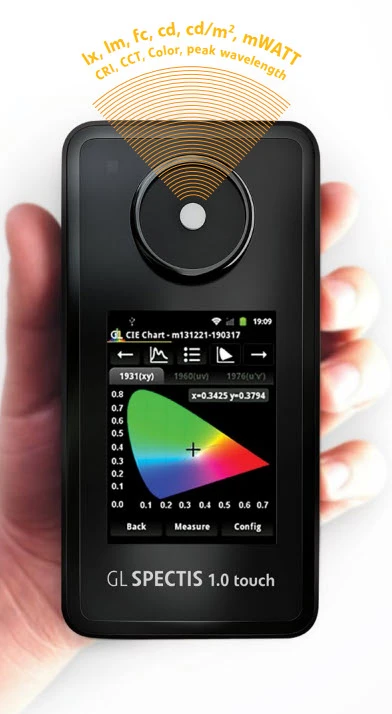
GL SPECTIS 1.0 touch
If you are looking for reliable, precise and intuitively operated spectral instrument for light assessment, our state-of-the-art light measuring tool GL SPEC TIS 1.0 touch is the best answer to all your spectral light measurement needs.
Now not only experts can obtain dependable light measurement data – our preconfigured, individually calibrated measurement instruments deliver fast and precise results, and the included software is intuitive and easy to navigate. If you need to measure:
and much more…- Lux – illumination value
- Lumen – the luminous flux
- CRI – color rendering index according to CIE
- CCT – correlated color temperature according to CIE standard
- COLOR – color coordinates according to CIE 1931 and CIE 1964
- mWatt – radiant power value

Technical data sheet | |
Spectral range | 340-780nm (UVa-VIS) / 640-1050nm ( VIS-NIR) |
Detector | CMOS image sensor |
Numer of pixels | 256 |
Physical resolution | ~ 1.7nm / ~ 1.8nm |
Wavelength reproducibility | 0.5nm |
Integration time | 5ms to 100s |
A/D conversion | 16 bits |
Signal to noise ratio | 1000:1 |
Stray light | 2*10E-3 |
Spectroradiometric accuracy | 4% |
Measurement uncertainty of color coordinates (x.y) | 0.0015 |
Power | lithium-ion battery 1400 mAh |
Power consumption | ~ 640 mA |
Power supply | Input: AC 100-240V 50/60 Hz 0.15 A / Output: 5 V-1 A |

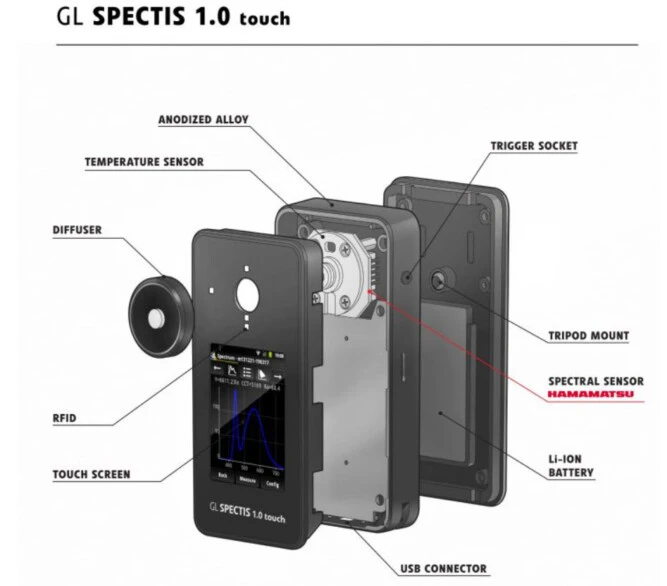
+ LUMINOUS FLUX MEASUREMENT [lm] Radiant power measurement [mW]
GL OPTI SPHERE 48
Measure radiant power, luminous flux, color temperature, color coordinates and color rendering index (CRI) of LEDs.
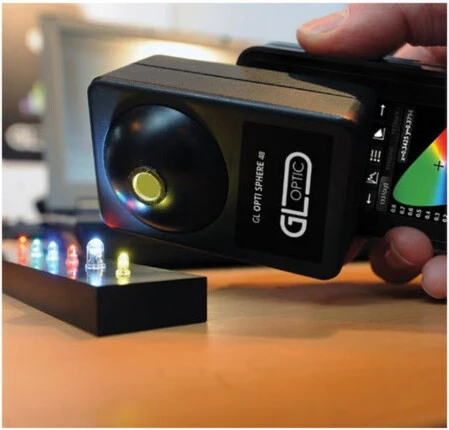
GL OPTI SPHERE 48 for single LEDs
GL Optic offers a unique solution for luminous flux measurements, color CRI and TM30 rendering properties of LEDs of single LEDs.
GL OPTI SPHERE 48 is an accessory that can be combined with our spectrometers to create a portable measurement set.
Did you know that electric current, electronic drivers and even heat may negatively affect the lighting properties of LEDs?
These are some of the reasons why you would need an integrating sphere to measure the performance of single LEDs once they are installed on the PCB.
This compact and portable set can be carried in a case, so you can bring it to meetings with your suppliers or customers.
What is luminous flux?
It is the total measurement of the perceived power of light in relation to the spectral sensitivity of the human eye.
How do we measure it?
Luminous flux is measured with a spectrometer connected to an integrating sphere. This method allows us to determine the total amount of energy emitted by an examined source in all directions.
The SI unit of luminous flux is lumen [lm].
What does it give us? It allows us to determine the total amount of light emitted by a source in every direction, taking into account the sensitivity of the human eye.
Such a measurement provides a basis for calculating other parameters and can be used for comparing different light sources
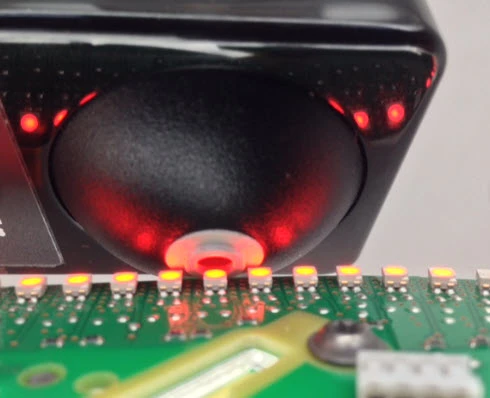
+ LUMINANCE MEASUREMENT [cd/m2 ]
Luminance and Radiance
Available luminance optical probes can be connected and calibrated with our device to measure flat emitting surfaces like displays, screens and back lights.
The coding system installed in our spectrometer will automatically download calibration file and measure cd/m2.
GL OPTI PROBE 1.0.10 LUMINANCE for display measurements
GL OPTI PROBE 1.0.10 LUMINANCE is an accessory which is designed to be used with our GL SPECTIS 1.0 Touch for luminance measurements of flat displays, LCD and LED panels, as well as plasma FPDs.
It is also the perfect solution for testing projection displays as well as OLED light sources.
The measurement provides accurate readings of luminance [cd/m2 ] and color coordinates (x, y, Y) conforming to CIE standards.
This accessory connects to the spectrometer with fiber optic connection and can be installed on a tripod at a distance from the test device or put directly on the LED or OLED surface to measure cd/m2, SPD and radiance.
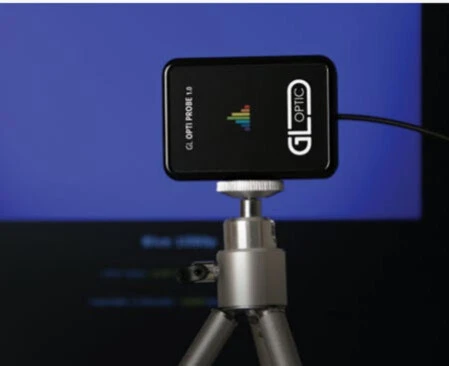
What is luminance?
Luminance is a photometric measure of luminous intensity of light that is emitted or diffused by a particular area.
How is it measured and what unit is used?
It is measured with a lens directed towards the examined surface. The SE unit is candela per square meter [cd/m²].
What does it give us?
It allows us to assess the brightness of a particular surface and is especially useful when measuring the brightness of screens and displays, airport aprons and runways, roads lit with street lamps, etc.
GL SPECTIS 1.0 Touch + Flicker Usage
Every Important Metric, One Device
TV and Studio Light Flicker
Use our GL Spectis 1.0 Touch light spectrometer + Flicker to measure very high frequencies up to 12 kHz which are important for broadcasting and studio lighting evaluation. This will also include CCT, CRI and TLCI indices verified.
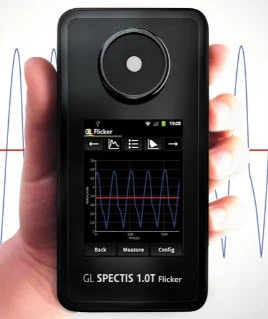
When the first “flicker-free” football stadium lighting was installed at Chelsea Arena in the UK, GL Optics was asked to provide a device which could be used as an auditing tool to check the newly installed lighting.
The contractor needed to evaluate the photometric and colorimetric values including illumination (lx), color temperature (CCT), color rendering properties of LED (CRI), television index (TI) and additionally verify if it was a flicker-free installation.
This project triggered the development of the Spectis 1.0 Touch + Flicker, improving on our existing GL Spectis 1.0 Touch by integrating an additional electronic circuit board with the fast photodiode to capture the optical flicker characteristics.
The result is possibly the best hand-held flicker spectroradiometer on market.
Covering an exceptional wide range of frequencies with accuracy equal to some laboratory devices.
GL Optic takes an active part in a Philips Working Group which is focused on establishing new flicker metric standards throughout the industry.
Thanks to this direct cooperation we have an opportunity to compare and evaluate our accuracy daily using the reference standard provided by Philips.
We are also able to include the latest flicker metrics like Flicker Index, Flicker Percent and the Flicker Ratio together with the latest SVM (Stroboscopic Visibility Measure) – a new standard to assess how the lighting installation might influence human visibility performance.
The GL Spectis 1.0 T Flicker meter is an intuitively operated touch screen portable light spectrometer, equally suited to the lab as it is in the field.
With a range of software analysis capabilities and extensive suite of accessories, this device is in a category all its own.
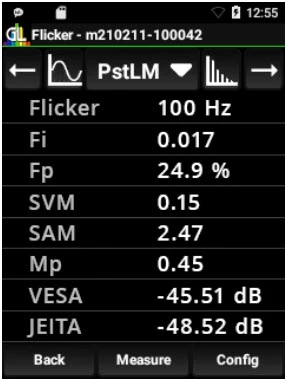
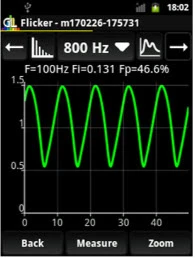
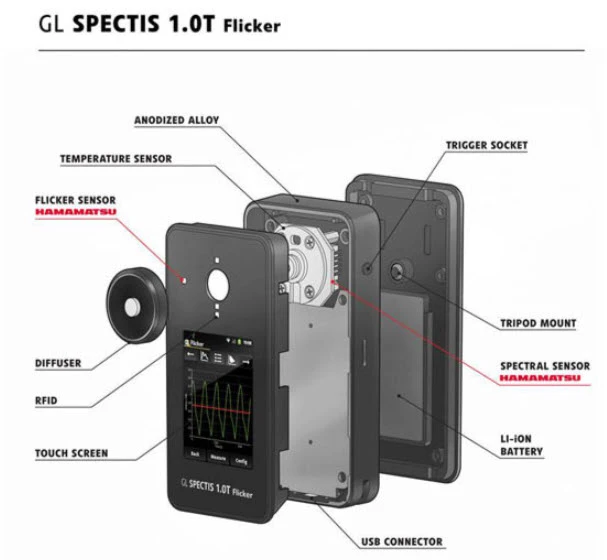

GL SPECTROSOFT
It is a helpful tool for laboratory applications, as well as for field work in production quality control and for general light assessment purposes.
The software interface gives the user quick access to useful information and functions.
The program calculates color coordinate values according to CIE standards.
Other calculations include correlated color temperature CCT, chromaticity error, peak wavelength, dominant wavelength, color rendering index CRI (CIE 13.3).
Additionally it can calculate scotopic and photopic values, PAR and PPFD, McAdam’s ellipses and much more...
GL SPECTROSOFT v. 3.0 NEW FEATURES
• MacAdam ellipses and Duv +/-
• PASS/FAIL function for production applications
• Personalized report generator using templates prepared with any text editor
• Peripheral devices management such as current sources, power supplies, TEC controllers
• Command line for LabVIEW™ and other systems
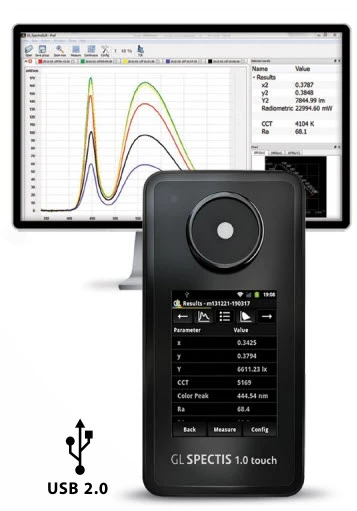
Delivery full measurement set including:
• GL SPECTIS 1.0 Touch - illuminance spectrometer, usb cable, power supply, leash, display protection foil 4 GB micros SD card & case
Optional accessories :• GL OPTI SPHERE 48 - integrating sphere for flux measurement - for single LED measurements• GL OPTI PROBE 1.0.10 LUMINANCE - luminance measurement accessory• GL SPECTIS 1.0 TOUCH + FLICKER
CALIBRATION
By selecting a GL Optic Light Measurement System, you are choosing one of the most accurate, reliable, precise and
intuitively operated spectrometers and light measuring technology available in the market today.
VERY IMPORTANT :
When you purchase a GL SPECTIS 1.0 Touch system, if you buy optical accessories at the same time as the instrument, they will be delivered calibrated, ready to use and will give you absolute measurements.
If you wish to purchase other accessories at a later date, their use without recalibration by GL Optic of the instrument/accessories set will provide you with relative values.
MAINTENANCE AND A 5-YEAR EXTENDED WARRANTY SYSTEM
All GL Optic equipment
and SPECTROSOFT software is fully guaranteed, however, as with all precision light measurement instruments, they
require regular expert maintenance, re-calibration and software updates to maintain optimum performance within
the manufacturer’s specifications and tolerances.
GL Optic offers their customers fast and professional service for equipment support, maintenance and repairs.
We offer the industry’s most extended maintenance program to help keep your instruments running like new.
An extended 5-year warranty system is available for customers who wish to opt for regular calibration of their
instruments at the GL Optic laboratory.

